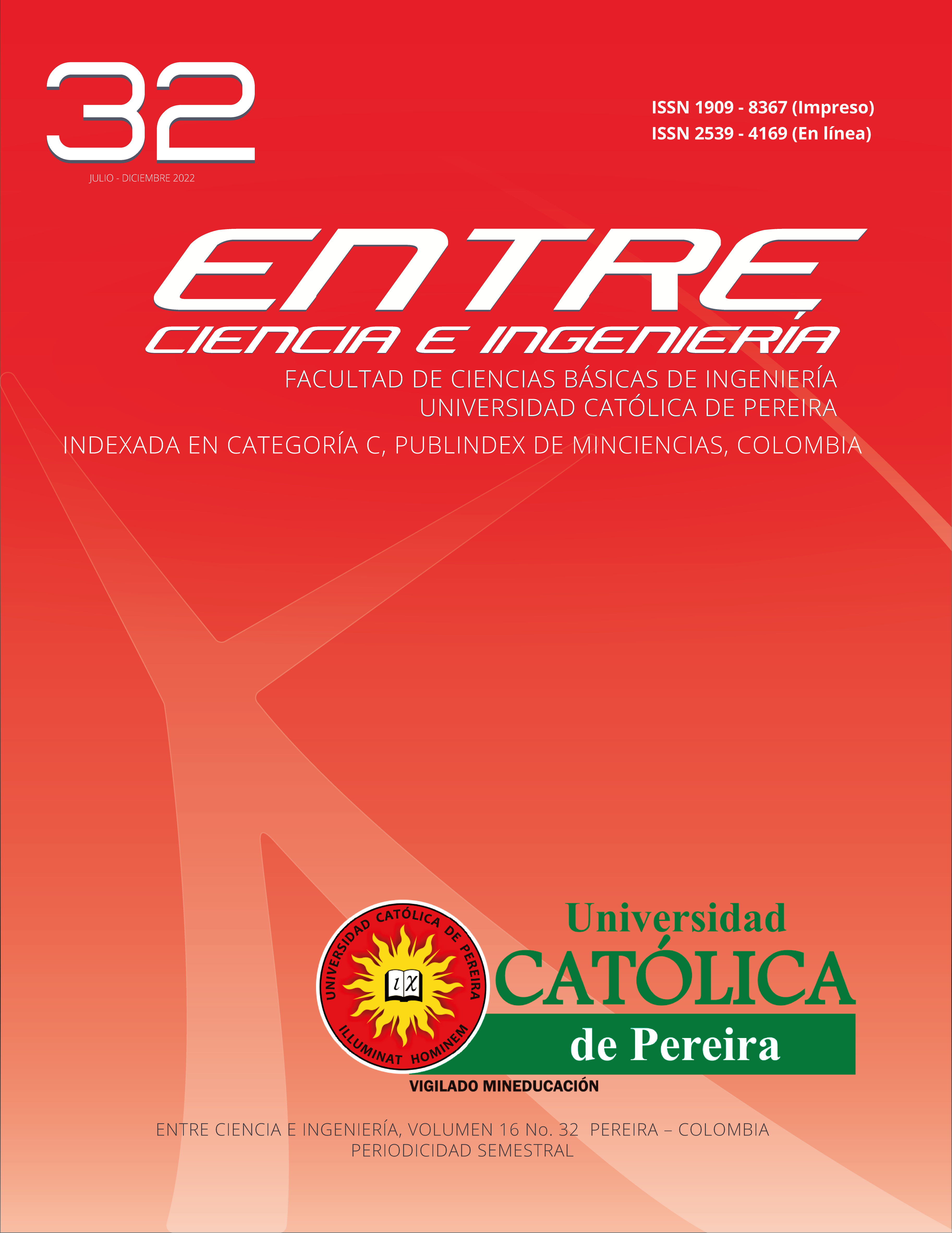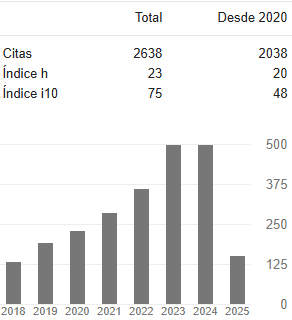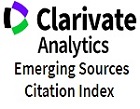Revisión del potencial de obtención de biohidrógeno a partir de microalgas en Colombia
DOI:
https://doi.org/10.31908/19098367.2798Palabras clave:
Biocombustibles, biofotólisis, fermentación oscura, hidrógeno, microalgasResumen
El hidrógeno es un vector energético indispensable pensando en una transición a un sistema descarbonizado y las microalgas son uno de los recursos más prometedores para su producción. El objetivo de este trabajo es realizar una revisión de estudios realizados para la producción de biohidrógeno a partir de microalgas para determinar y evaluar los diferentes métodos de producción y aquellos factores que los afectan, así como sus limitaciones, considerando investigaciones realizadas en todo el mundo y especialmente en Colombia. Los resultados han demostrado que la fermentación oscura tiene varias ventajas en comparación con otros métodos: no requiere grandes espacios de cultivo, la producción de hidrógeno es rápida y eficiente, y se pueden obtener subproductos valiosos. Esto convierte al biohidrógeno en una alternativa energética atractiva para el país.
Descargas
Referencias
E. S. Hanley, J. P. Deane, y B. Ó. Gallachóir, “The role of hydrogen in low carbon energy futures – A review of existing perspectives”. Renewable and Sustainable Energy Reviews., vol. 82, pp. 3027-3045, 2018.
C. Acar, and I. Dincer, “Review and evaluation of hydrogen production options for better environment”. Journal of cleaner production., vol. 218, pp. 835-849, 2019.
H. Singh, and D. Das, “Biohydrogen from microalgae. In Handbook of Microalgae-Based Processes and Products”. Academic Press, 2020, pp. 391-418.
D. Das, N. Khanna, and C.N. Dasgupta, “Biohydrogen production: fundamentals and technology advances”. CRC Press, 2014, pp. 370.
K. Dos Santos et al., “Hydrogen production in the electrolysis of water in Brazil, a review”. Renewable and Sustainable Energy Reviews., vol. 68, pp. 563-571, 2017.
J. Jimenez-Llanos et al., “Sustainable biohydrogen production by Chlorella sp. microalgae: A review”. International Journal of Hydrogen Energy., vol. 45(15), pp. 8310-8328, 2020.
M. G. Romero, “Biocombustibles y producción de biohidrógeno”. MoleQla: revista de Ciencias de la Universidad Pablo de Olavide., (38), pp. 8, 2020.
Y. Pardo-Cárdenas et al., “Environmental assessment of microalgae biodiesel production in Colombia: comparison of three oil extraction systems”. CT&F Ciencia, Tecnología y Futuro., vol. 5(2), pp. 85-100, 2013.
C. Posten, and C. Walter, “Microalgal biotechnology: integration and economy”. Walter de Gruyter, 2012, pp. 319.
D. C. Gonzales, D. M. Hernandez, y A. T. R. Chaparro, “Producción de biohidrógeno a partir de microalgas”. Energética., vol. 47, pp. 51-64, 2016.
M. Oey et al., “Challenges and opportunities for hydrogen production from microalgae”. Plant biotechnology journal., vol. 14(7), pp. 1487-1499, 2016.
E. Jacob-Lopes et al., “Handbook of Microalgae-Based Processes and Products: Fundamentals and Advances in Energy, Food, Feed, Fertilizer, and Bioactive Compounds”. Academic Press, 2020, pp. 905.
K. Chandrasekhar, Y. J. Lee, and D. W. Lee, “Biohydrogen production: strategies to improve process efficiency through microbial routes”. International journal of molecular sciences., vol. 16(4), pp. 8266-8293, 2015.
K. Batyrova, and P.C. Hallenbeck, “Sustainability of biohydrogen production using engineered algae as a source”. In Biohydrogen Production: Sustainability of Current Technology and Future Perspective. Springer. pp.163-180, 2017.
A. I. Osman et al., “Critical challenges in biohydrogen production processes from the organic feedstocks”. Biomass Conversion and Biorefinery., pp. 1-19, 2020.
D. M. Revelo, N. H. Hurtado, y J. O. Ruiz, “Celdas de combustible microbianas (CCMs): Un reto para la remoción de materia orgánica y la generación de energía eléctrica”. Información tecnológica., vol 24(6), pp. 17-28, 2013.
B. Zhang et al., “Nitrogen-doped activated carbon as a metal free catalyst for hydrogen production in microbial electrolysis cells”. RSC Advances., vol. 4(90), pp. 49161-49164, 2014.
A. Saravanan et al., “Microbial electrolysis cells and microbial fuel cells for biohydrogen production: current advances and emerging challenges”. Biomass Conversion and Biorefinery., pp. 1-21, 2020.
S. Chader et al., “Biohydrogen production using green microalgae as an approach to operate a small proton exchange membrane fuel cell”. International journal of hydrogen energy., vol. 36(6), pp. 4089-4093, 2011.
E. B. Estrada-Arriaga et al., “Assessment of a novel single-stage integrated dark fermentation-microbial fuel cell system coupled to proton-exchange membrane fuel cell to generate bio-hydrogen and recover electricity from wastewater”. Biomass and Bioenergy., vol. 147, pp. 106016, 2021.
L. Wobbe, and C. Remacle, “Improving the sunlight-to-biomass conversion efficiency in microalgal biofactories”. Journal of biotechnology., vol. 201, pp. 28-42.
S. P. Slocombe, J. R. Benemann, “Microalgal production for biomass and high-value products”. CRC Press, 2017, pp. 325.
S. K. Kim, “Handbook of marine microalgae: Biotechnology advances”. Academic Press, 2015, pp. 585.
P.M. Budiman, and T.Y. Wu, “Role of chemicals addition in affecting biohydrogen production through photofermentation”. Energy Conversion and Management., vol. 165, pp. 509-527, 2018.
A. Melis, “Solar energy conversion efficiencies in photosynthesis: minimizing the chlorophyll antennae to maximize efficiency”. Plant science., vol. 177(4), pp. 272-280, 2009.
E. Eroglu, and A. Melis, “Photobiological hydrogen production: recent advances and state of the art”. Bioresource technology., vol. 102(18), pp. 8403-8413, 2011.
A. Pandey et al., “Biofuels from algae”. Newnes, 2013, pp. 338.
D. Nagarajan et al., “Recent insights into biohydrogen production by microalgae–From biophotolysis to dark fermentation”. Bioresource technology., vol. 227, pp. 373-387, 2017.
T. K. Antal, T. E. Krendeleva, and A. B. Rubin, “Acclimation of green algae to sulfur deficiency: underlying mechanisms and application for hydrogen production”. Applied microbiology and biotechnology., vol. 89(1), pp. 3-15, 2011.
D. J. Lee, K. Y. Show, and A. Su, “Dark fermentation on biohydrogen production: pure culture”. Bioresource technology., vol. 102(18), pp. 8393-8402, 2011.
D. Das, and T.N. Veziroglu, “Advances in biological hydrogen production processes”. International journal of hydrogen energy., vol. 33(21), pp. 6046-6057, 2008.
O. Bičáková, and P. Straka, “Production of hydrogen from renewable resources and its effectiveness”. International Journal of Hydrogen Energy., vol. 37(16), pp. 11563-11578, 2012.
B. P. Nobre et al., “A biorefinery from Nannochloropsis sp. microalga–extraction of oils and pigments. Production of biohydrogen from the leftover biomass”. Bioresource technology., vol. 135, pp. 128-136, 2013.
C. Y. Chen, H. Y. Chang, and J. S. Chang, “Producing carbohydrate-rich microalgal biomass grown under mixotrophic conditions as feedstock for biohydrogen production”. International journal of hydrogen energy., vol. 41(7), pp. 4413-4420, 2016.
R. Wirth et al., “Anaerobic gaseous biofuel production using microalgal biomass–a review”. Anaerobe., vol. 52, pp. 1-8, 2018.
K. Paramesh et al., “Enhancement of biological hydrogen production using green alga Chlorococcum minutum”. International Journal of Hydrogen Energy., vol. 43(8), pp. 3957-3966, 2018.
H. R. Preisig, and R. A. Andersen, “Historical review of algal culturing techniques”. Algal culturing techniques., vol. 65, pp. 79-82, 2005.
Y. Wong et al., “Growth medium screening for chlorella vulgaris growth and lipid production”. J. Aquac. Mar. Biol., vol. 6(1), pp. 00143, 2017.
W.M. Alalayah et al., “Experimental investigation parameters of hydrogen production by algae Chlorella Vulgaris”. In International conference on Chemical, Environment & Biological Sciences (CEBS-2014)., pp. 17-18, Sept. 2014.
F. L. Alfonso Moreno, A. I. Páez Morales, y D. Torres Ramírez, “Evaluación de la producción de hidrógeno usando la bacteria clostridium butyricum en un reactor tipo cstr a escala laboratorio”. Publicaciones Universidad de América - Revista de Investigación., vol. 6(1), pp. 19-37, 2013.
A. Ciranna, “Biohydrogen production in extreme conditions: a comprehensive study of the fermentative metabolism of a polyextremophilic bacterium”. Tesis doctoral, Universidad de Tecnología de Tampere, Finlandia, 2014.
Y. C. Jeon, C. W. Cho, and Y. S. Yun, “Measurement of microalgal photosynthetic activity depending on light intensity and quality”. Biochemical Engineering Journal., vol. 27(2), pp. 127-131, 2005.
C. Posten, “Design principles of photo‐bioreactors for cultivation of microalgae”. Engineering in Life Sciences., vol. 9(3), pp. 165-177, 2009.
L. Li, L. Zhang, and J. Liu, “Proteomic analysis of hydrogen production in Chlorella pyrenoidosa under nitrogen deprivation”. Algal Research., vol. 53, pp. 102143, 2021.
A. A. Volgusheva et al., “Comparative analyses of H2 photoproduction in magnesium‐and sulfur‐starved Chlamydomonas reinhardtii cultures”. Physiologia plantarum., vol. 161(1), pp. 124-137, 2017.
D. Gonzalez-Ballester, J. L. Jurado-Oller, and E. Fernandez, “Relevance of nutrient media composition for hydrogen production in Chlamydomonas”. Photosynthesis research., vol. 125(3), pp. 395-406, 2015.
F. Oliveira et al., “Hydrogen photoproduction using Chlorella sp. through sulfur-deprived and hybrid system strategy”. Chemical Engineering Transactions., vol. 43, pp. 301-306, 2015.
R. Wirth et al., “Exploitation of algal-bacterial associations in a two-stage biohydrogen and biogas generation process”. Biotechnology for biofuels., vol. 8(1), pp. 1-14., 2015.
B. Ge et al., “Evaluation of various sulfides for enhanced photobiological H2 production by a dual-species co-culture system of Chlamydomonas reinhardtii and Thiomonas intermedia”. Process Biochemistry., vol. 82, pp. 110-116, 2019.
A. Dubini, and M.L. Ghirardi, “Engineering photosynthetic organisms for the production of biohydrogen”. Photosynthesis research., vol. 123(3), pp. 241-253, 2015.
S. N. Kosourov et al., “Maximizing the hydrogen photoproduction yields in Chlamydomonas reinhardtii cultures: the effect of the H2 partial pressure”. International journal of hydrogen energy., vol. 37(10), pp. 8850-8858, 2012.
D. Das, “A road map on biohydrogen production from organic wastes”. INAE Letters., vol. 2(4), 153-160, 2017.
K. Skjånes et al., “Design and construction of a photobioreactor for hydrogen production, including status in the field”. Journal of applied phycology., vol. 28(4), pp. 2205-2223, 2016.
A. M. Lakaniemi et al., “Biogenic hydrogen and methane production from Chlorella vulgaris and Dunaliella tertiolecta biomass”. Biotechnology for biofuels., vol. 4(1), pp. 1-12, 2011.
L. Xu et al., “Improved hydrogen production and biomass through the co-cultivation of Chlamydomonas reinhardtii and Bradyrhizobium japonicum”. International Journal of Hydrogen Energy., vol. 41(22), pp. 9276-9283, 2016.
G. Lakatos et al., “Factors influencing algal photobiohydrogen production in algal-bacterial co-cultures”. Algal research., vol. 28, pp. 161-171, 2017.
N. Rashid et al., “Characteristics of hydrogen production by immobilized cyanobacterium Microcystis aeruginosa through cycles of photosynthesis and anaerobic incubation”. Journal of Industrial and Engineering Chemistry., vol. 15(4), pp. 498-503, 2009.
S. Fouchard et al., “Investigation of H2 production using the green microalga Chlamydomonas reinhardtii in a fully controlled photobioreactor fitted with on-line gas analysis”. International journal of hydrogen energy., vol. 33(13), pp. 3302-3310, 2008.
A. K. Sadvakasova et al., “Bioprocesses of hydrogen production by cyanobacteria cells and possible ways to increase their productivity”. Renewable and Sustainable Energy Reviews., vol. 133, pp. 110054, 2020.
B. A. Cho, and R. W. M. Pott, “The development of a thermosiphon photobioreactor and analysis using Computational Fluid Dynamics (CFD)”. Chemical Engineering Journal., vol. 363, pp. 41-154, 2019.
B. Aslanbay Guler et al., “Computational fluid dynamics modelling of stirred tank photobioreactor for Haematococcus pluvialis production: Hydrodynamics and mixing conditions”. Algal Research., vol. 47, pp. 101854, 2020.
S. R. Vargas et al., “Anaerobic phototrophic processes of hydrogen production by different strains of microalgae Chlamydomonas sp.” FEMS microbiology letters., vol.365(9), pp. fny073, 2018.
T. T. Giang et al., “Improvement of hydrogen production from Chlorella sp. biomass by acid-thermal pretreatment”. PeerJ., vol. 7, pp. e6637, 2019.
W.M. Alalayah et al., “Influence of culture parameters on biological hydrogen production using green algae Chlorella vulgaris”. Rev Chim., vol. 66, pp. 788-791, 2015.
N. Rashid, K. Lee, and Q. Mahmood, “Bio-hydrogen production by Chlorella vulgaris under diverse photoperiods. Bioresource technology., vol. 102(2), pp. 2101-2104, 2011.
A. Ruiz-Marin, Y. Canedo-López, and P. Chávez-Fuentes, “Biohydrogen production by Chlorella vulgaris and Scenedesmus obliquus immobilized cultivated in artificial wastewater under different light quality”. AMB Express., vol. 10(1), pp. 1-7, 2020.
F. L. Alfonso Moreno, y D. Rubio Fernández, “Generación de biohidrógeno por un proceso de biofotólisis directa utilizando un cultivo mixto de microalgas”. Publicaciones Universidad de América - Revista de Investigación., vol. 3(2), pp. 7-18, 2010.
A. P. Batista et al., “Combining urban wastewater treatment with biohydrogen production–an integrated microalgae-based approach”. Bioresource technology., vol. 184, pp. 230-235, 2015.
A. P. Batista et al., “Scenedesmus obliquus as feedstock for biohydrogen production by Enterobacter aerogenes and Clostridium butyricum”. Fuel., vol. 117, pp. 537-543, 2014.
A. Bedoya et al., “Producción biológica de hidrógeno: una aproximación al estado del arte”. Dyna., vol. 75(154), pp. 137-157, 2008.
A.P. Frias, Á. D. González-Delgado, and V. Kafarov, “Microalgae biorefinery trought optimization of strain composition and biomass consumption”. Chemical Engineering., vol. 43, pp. 589-594 2015.
M. Bernal et al., “Evaluating Colombian Clostridium spp. strains hydrogen production using glycerol as substrate”. Electronic journal of biotechnology., vol. 16(2), pp. 5-5, 2013.
Descargas
Publicado
Número
Sección
Licencia
Derechos de autor 2022 Entre Ciencia e Ingeniería

Esta obra está bajo una licencia internacional Creative Commons Atribución-NoComercial 4.0.



















